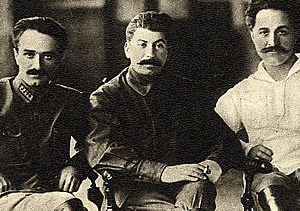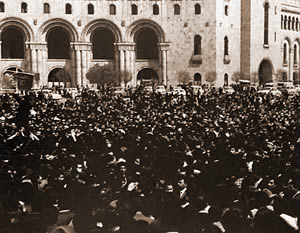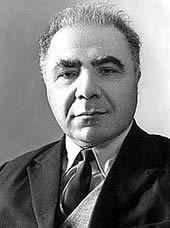USSR (part 2)
The new wave of Armenian migration
In 1946, many patriotic Armenians from the foreign Armenian colonies decided to repatriate to their historical homeland to contribute the post-war restoration. However, in years1948-1949, Stalin launched a new campaign of terror, and thousands of those repatriated Armenians were illegally arrested and forcibly deported to Siberia and Altay.
From the beginning of the 60s, Armenians began to emigrate from the Soviet Union on a large-scale. The Soviet leaders considered the Armenians, together with the Jews and the Germans as “unreliable elements” of the Soviet system.
Rebirth of Armenia
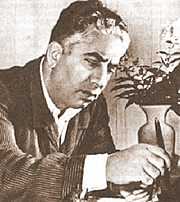 Composer Aram Khachaturian, the iconic figure in Armenian music. After the death of Stalin, the new Soviet leader Nikita Khrushev initiated a campaign of de-Stalinisation which allowed liberalization of cultural and intellectual life. Almost immediately, a rapid cultural and economic growth began in Armenia. Several Armenian, including politicians, scientists, writers and music composers rose to prominence. Among them were Anastas Mikoyan, influential political figure, his brother Artem Mikoyan, designer of the Soviet MiG fighter jet company, world-wide famous music composer Aram Khachaturian, and the renowned astrophysicist Viktor Hambartsumyan.
Composer Aram Khachaturian, the iconic figure in Armenian music. After the death of Stalin, the new Soviet leader Nikita Khrushev initiated a campaign of de-Stalinisation which allowed liberalization of cultural and intellectual life. Almost immediately, a rapid cultural and economic growth began in Armenia. Several Armenian, including politicians, scientists, writers and music composers rose to prominence. Among them were Anastas Mikoyan, influential political figure, his brother Artem Mikoyan, designer of the Soviet MiG fighter jet company, world-wide famous music composer Aram Khachaturian, and the renowned astrophysicist Viktor Hambartsumyan.
Vazgen I
 Vazgen I, Catholicos of All Armenians
Vazgen I, Catholicos of All Armenians
Also, to some degree, Armenia enjoyed some religious freedom as compared to other republics of the Soviet Union. When Catholicos Vazgen I assumed the duties of his office in 1955, he carried a relatively independent policy which gradually asserted some independence for his church in face of the totalitarian Soviet rule in the Armenian Republic. He saved a number of church treasures, founded institutions and museums, restored old Armenian churches, and intensified contacts with Armenian diaspora.
The Genocide commemorated
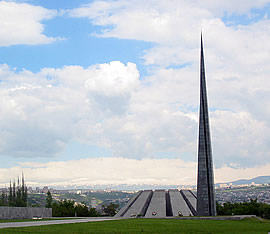 Tzizernakaberd (Swallow’s fortress), Armenian Genocide Memorial in Yerevan, capital of Armenia. source: Wikipedia Commons. On April 24, 1965 the Armenians throughout the world took part in the mass meetings and manifestations, to commemorate the 50-th anniversary of the Armenian Genocide. In Yerevan, Soviet troops entered the city and attempted to restore order. a grand monument was raised to the 1915-1921 victims’ memory. Since then, the funeral marches and meetings on April 24 became an Armenian tradition.
Tzizernakaberd (Swallow’s fortress), Armenian Genocide Memorial in Yerevan, capital of Armenia. source: Wikipedia Commons. On April 24, 1965 the Armenians throughout the world took part in the mass meetings and manifestations, to commemorate the 50-th anniversary of the Armenian Genocide. In Yerevan, Soviet troops entered the city and attempted to restore order. a grand monument was raised to the 1915-1921 victims’ memory. Since then, the funeral marches and meetings on April 24 became an Armenian tradition.
At the same time, the Armenian colonies and organizations abroad began the large-scale campaign for the recognition of the Genocide. In the 70s, a number of secret organizations were founded, such as ARA (Armenian Revolutionary Army) and ASALA (Armenian Secret Army for the Liberation of Armenia). These organizations stated to have no faith in the effectiveness of the peaceful demonstrations, and were involved in the terrorist activities. During the following decade, many terrorist attempts were committed against the Turkish representatives in the European countries, in order to attract public attention.
The Karabakh Question
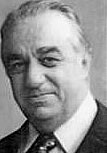 Anton Kochinyan
Anton Kochinyan
The Armenian liberation movement also manifested itself in several petitions of Armenians of Nagorno-Karabakh, requiring the reunification with Armenia. The leaders of the USSR discussed the problem in 1967-1970, while Anton Kochynian, Armenian 1st Secretary carried on the fruitless negotiations with the Azeri leaders Akhundov and Aliyev. In 1977, the problem of Nagorno-Karabakh was raised again. However, the issue was shelved again.
Karen the Builder
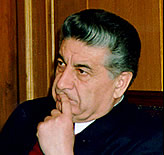 Karen Demirchyan
Karen Demirchyan
Under Karen Demirchyan, the 1st Secretary from 1975, the economy of Armenia went through the period of stagnation, just like the economies of the rest of the Soviet Union, in the era of Leonid Brezhnev. However, Demirchyan succeeded in construction and house building and later was deservedly nicknamed as Karen the Builder. Various sites and new buildings modernized Armenia, especially Yerevan. Armenia became a highly urbanized Republic.


